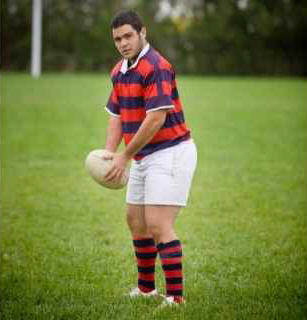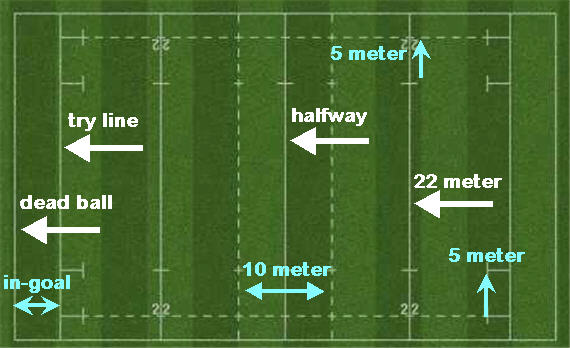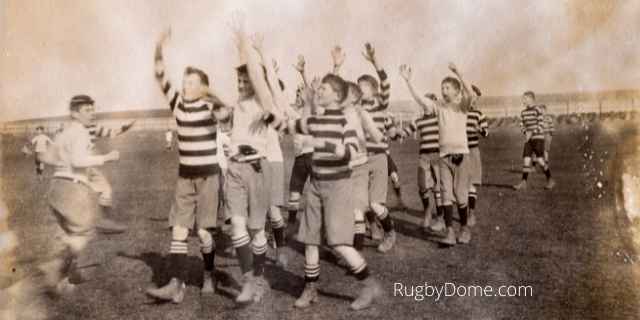Drop kicking is one of the more difficult skills to master. Usually, only a few players on a team will try a drop kick during a match.
This article explains exactly what they are and when they are used in modern rugby. We’ll also take a look back in time to when they were a more important part of winning matches.
What Is A Drop Kick?

A drop kick in rugby occurs when a player drops the ball from their hands and kicks it as or immediately after it touches the ground.
Drop kicks are used to score goals. They are also mandatory in some parts of play such as starting the match or restarting after half-time.
Drop kicking versus punting
If the player kicks the ball before it hits the ground, this is usually referred to in rugby as just a “kick”.
It may also be referred to as “punting” the ball, although this is a more common term in American football.
What Is A Drop Goal?
A drop goal is scored when a player drop kicks the ball between the opposition posts and over the crossbar.
Drop goals are worth three points and are usually scored from open play.
The nearest defenders will try to charge the kick down or at least put enough pressure on the kicker that they fail to kick accurately.
Famous drop goals
In the 1999 Rugby World Cup, Springbok flyhalf Jannie de Beer kicked five drop goals in a quarter-final against England.
A young Jonny Wilkinson came on as a replacement in that match but couldn’t turn England’s fortunes around.
I well remember being astonished at such a feat.
Jannie de Beer still holds the record for the highest number of drop goals scored by a player in an international match.
I mentioned Jonny Wilkinson, and by 2003 he was the first choice England flyhalf. In the World Cup final against Australia, Wilkinson held his nerve to slot a drop goal in extra time to win the trophy.
It’s probably the most famous drop goal in rugby.
But I should also mention Dan Carter, the great New Zealand flyhalf, whose drop goal was the winning score against Australia in the World Cup of 2015.
Both Wilkinson and Carter are on our list of the greatest flyhalves in rugby. You’ll have to check the article to see which ranks above the other!
Using drop kicks for penalties or conversions
If you watch a Rugby Sevens match (with seven players each side), you’ll notice that penalties and conversions are only taken as drop kicks. This is mandatory in this version of rugby.
However, penalties and conversions in the fifteen-player sport can also be taken as a drop kick.
But using a kicking tee gives more accuracy. Why would anyone choose to use a drop kick?
Well, it’s rare, but you’ll sometimes see it done for a conversion. This is because the action is much faster to execute. Read on…
Clawing back time
The most common scenario is when a team scores in the final minute of a match, but they still need another try or penalty to win the game.
The kicker doesn’t want to use up many seconds to line up the ball on the kicking tee. The team may run out of time if the kicker takes the full minute that’s allowed.
Instead, the kicker takes a few seconds to kick a drop goal. This can leave time for the opposition to have to restart the game (with a drop kick).
Why Drop Kicking Is Hard To Do Well

It’s more difficult to drop kick a rugby ball with accuracy than it is to punt it i.e. kick it before it hits the ground.
This is because of the oval shape of the ball. The kicker wants the ball to behave consistently i.e. travel in the right direction and at the right height.
But the pointed end means that the ball must be dropped at the right angle and kicked in the right spot every time. Players who are expected to execute this skill in a match will practice it for hours.
Who Takes Drop kicks In Rugby?
The outhalf usually takes most of the drop kicks during a match. That includes starting the first or second half.
Sometimes you’ll see a different player taking this kick-off role at club or international level. This tends to be either the fullback or the scrumhalf. Both must be excellent kickers.
Also, fullbacks put hours of practice into scoring drop goals (explained later), which hones their overall technique.
Of course, any player can try to drop kick a goal.
Zinzan Brook, the All Blacks’ number eight, drop kicked a long-distance goal in a 1995 World Cup match.
When Is A Drop Kick Mandatory?
Drop kicks are mandatory in rugby in several situations that have specific names.
We’ll give you the jargon here, and then explain each scenario in some detail.
- Kick-offs
- 22-metre dropout
- Goal-line dropout
Kick-offs
The “kick-off” refers to starting the first or second half of a match. It’s also known as a “restart”.
One team takes a drop kick from the halfway line to start the match. The other team takes the drop kick to start the second half.
The main rules are:
- The ball must travel at least ten metres forward
- It must not go directly out of play from the kick
If you want to learn more, we have a full article on how kick-offs work in rugby.
22-metre dropout
There are two scenarios that lead to a drop kick from the 22-metre line.
Before I get into it, I’ll quickly explain what the “dead-ball line” is on the pitch. Here’s a handy pic, with the dead-ball line shown for one side of the pitch.

The area behind the posts in which the attacker can ground the ball to score a try is the “in-goal” area. The final boundary is the “dead-ball” line.
If the ball passes that line, it is out of play i.e. it has gone dead.
Now let’s get back to one of the two scenarios.
If a player kicks the ball so far that it goes over the dead-ball line, then the opposition gets a 22-metre dropout from within their own half.
The second scenario is when a player attempts to kick a penalty or drop-goal but misses. If an opposition player catches the ball behind the try line and grounds it, then his team gets a 22-metre dropout.
Goal-line dropout
Goal-line dropout are a relatively new innovation in rugby.
The laws have changed over what happens when the attacking team kicks the ball into the in-goal area and a defender grounds it.
This used to be a five-meter scrum to the attacking team. Now, the defending team gets a drop kick from within the in-goal area.
A similar change has happened if an attacker gets over the line but can’t ground the ball because a defender gets between the ball and the ground.
Drop Kicks Used To Be More Important In Rugby

Now for a bit of history!
The origins of rugby date back to the late 19th century in English schools and universities.
Up until 1886, drop kicking was crucial. Drop goals were the only way to score points!
A “try” was worth no points itself. Instead, it allowed the team to attempt a drop kick or place kick to score. That’s why it’s still called a try!
In 1886, the English Rugby Football Union introduced points for tries.
However, drop goals continued to be worth more points. Specifically, they were four points versus two points for the try.
So, drop kicks were still crucially important.
That continued until 1948 when the points for a drop goal were reduced from four to the current three points. Over the next decades, tries were slowly increased in points (and value).
Nowadays, a converted try is seven points versus the three points for a drop goal. This is why teams usually strive to cross the try line instead of hanging back and drop kicking for a goal.